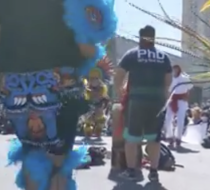Tletl (Mexican Nahua Dance) Performance Favorite
The group known as Kalpulli Yaocenoxtli, which practices Mexican Nahua dance, song and drumming, is a frequent presence at Black Lives Matter protests in Minneapolis and St. Paul. Its dancers first took to the streets in solidarity with the movement after the death of Jamar Clark, who was shot and killed by Minneapolis police in 2015.
“An injustice to one of us is an injustice to all,” said Sergio Cenoch, who directs the group with his wife, Mary Anne Quiroz, when the two spoke by phone just before a vigil for Mr. Floyd in Minneapolis. “That’s the message we want to convey when we’re out there supporting.”
A recent video posted on Instagram by a Kalpulli member, Samuel B. Torres, shows the dancers in bright regalia, kneeling outside the Fifth Precinct of the Minneapolis Police Department. After leading protesters in a chant of “George Floyd! Say his name!” they leap to their feet to an accelerating drum beat.
“One of the dances that we do a lot is called Tletl, which is fire,” Mr. Cenoch said. “We do that to spark fire and have it be felt across everybody that is watching, to try to get them connected to what is going on, and get that fire within their soul lit.”
Ms. Quiroz added that the dances they bring to protests “have survived colonization, have survived over 500 years.” To keep them alive “is a symbol of resistance,” she said, noting the connections between the struggles of black and Indigenous people. “It’s a symbol of resilience.”
Video of dance performance: https://www.instagram.com/p/CA1pj1XAGWf/?utm_source=ig_embed&ig_rid=3b4d...







